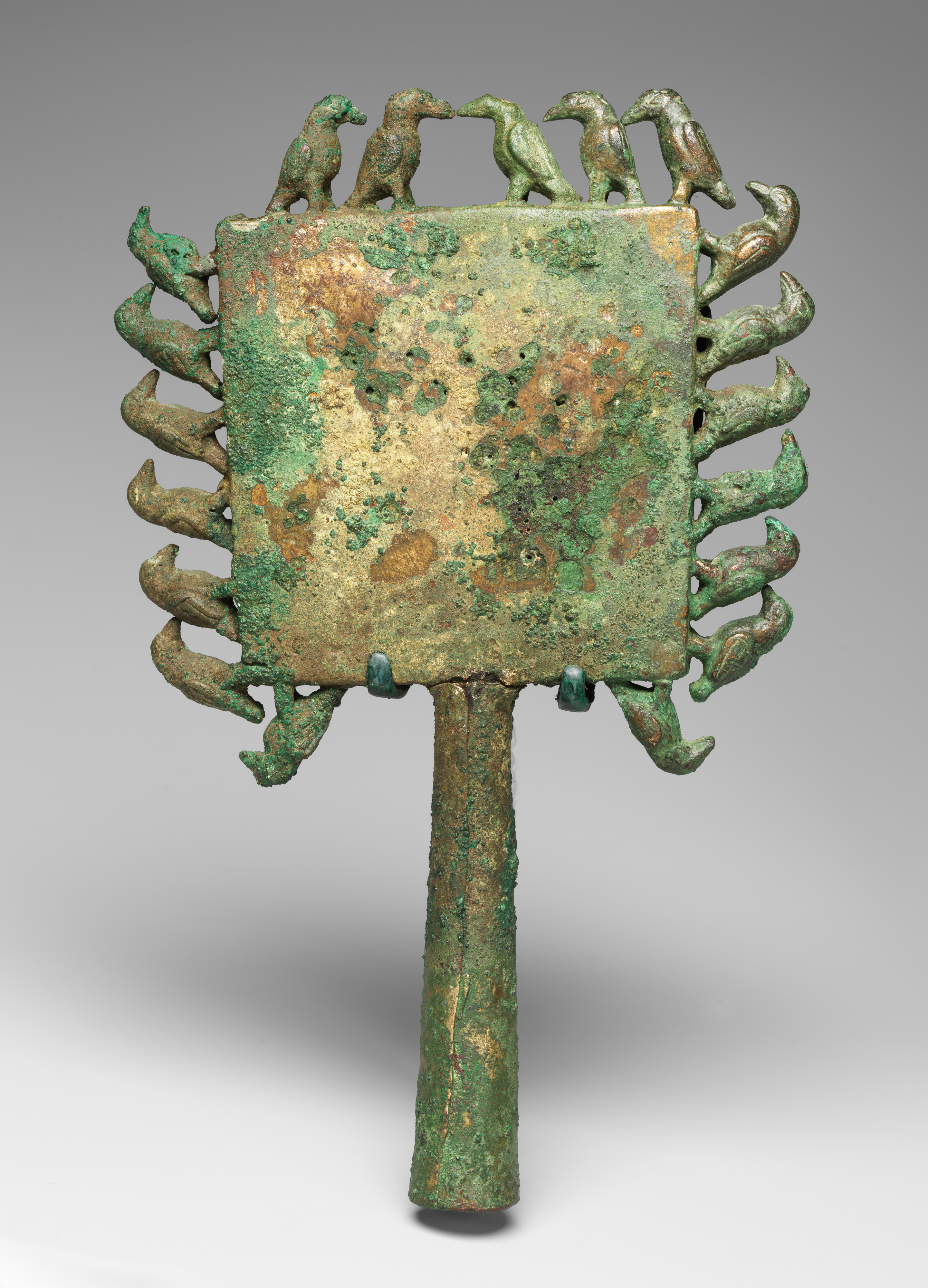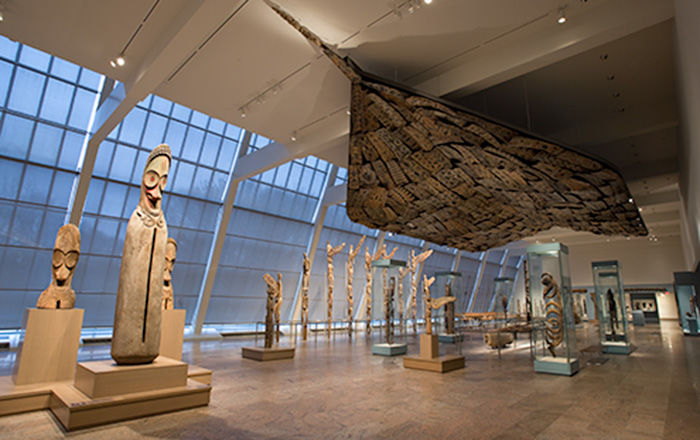Mirror with Birds
Not on view
This gilded copper mirror, made by artists of ancient Peru’s Moche culture, is one of the few from this North Coast society to survive to the present day. The trapezoidal frame is decorated with a procession of birds facing upward on each side and meeting on the top. (One bird on the right side of the top is missing.) The frame sits upon a hollow, tapered cylindrical handle, which was made separately, as were the birds, and soldered to the frame. Small areas of the original gilding are visible on the handle. The pyrite reflecting surface is a modern replacement.
Mirrors made of polished anthracite, pyrite or obsidian are known from as early as the first millennium BCE in the Andean region (Burger, 1992; Rick, 2004). The purpose of these mirrors is unclear, but a Wari ceramic vessel (Sawyer,1968: 73, fig. 578; 107, fig. 578) illustrates a man plucking his beard while looking into a mirror and two Nasca ceramics depict women holding up what appear to be mirrors (Denver Museum of Art, 1969.289; Museum zu Allerheiligen, 1992: 145, fig. 8.38).
Almost all Precolumbian Peruvian mirrors used wood as a support. This mirror is unusual as it has a gilded copper frame and backing. In addition, although most Moche metal objects from the southern region were fabricated from sheet metal, this mirror was made using the technique of lost-wax casting—the preferred method used to produce copper objects at the northern Moche site of Loma Negra. The use of casting at Loma Negra may have reflected the influence of communities to the north, in what is now Ecuador, where lost-wax casting was more common. The southern Moche were not unfamiliar with casting, however, as seen in the magnificent gold and silver cast scepters found at Sipán (Alva and Donnan, 1993: 96-101).
The Moche (also known as the Mochica) flourished on Peru’s North Coast from 200-850 CE, centuries before the rise of the Incas. Over the course of some seven centuries, the Moche built thriving regional centers from the Nepeña River Valley in the south to as far north as the Piura River, near the modern border with Ecuador, developing coastal deserts into rich farmlands and drawing upon the abundant maritime resources of the Pacific Ocean’s Humboldt Current. Although the precise nature of Moche political organization is unknown, these centers shared unifying cultural traits such as religious practices (Donnan, 2010).
References and Further Reading
Alva, Walter, and Christopher B. Donnan. Royal Tombs of Sipán. Los Angeles: Fowler Museum of Cultural History, University of California Los Angeles, 1993.
Burger, Richard. Chavin and the Origins of Andean Civilization. London: Thames and Hudson, 1992.
Castillo, Luis Jaime, Cecilia Pardo, and Julio Rucabado. Moche y sus vecinos: Reconstruyendo identidades. Lima: Museo de Arte de Lima, 2016.
Centeno, Silvia A., and Deborah Schorsch. “The Characterization of Gold Layers on Copper Artifacts from the Piura Valley (Peru) in the Late Intermediate Period.” In Gilded Metals: History, Technology and Conservation, edited by Terry Draymen-Weisser. London: Archetype Publications, 2000.
Cook, Anita G. 1996. “Mosaic Mirror.” In Andean Art at Dumbarton Oaks, Vol. 1, edited by E. H. Boone. Washington, D.C.: Dumbarton Oaks Research Library and Collection, pp. 181-186.
Donnan, Christopher B. “Moche State Religion.” In New Perspectives on Moche Political Organization, edited by Jeffrey Quilter and Luis Jaime Castillo, pp. 47-69. Washington D.C.: Dumbarton Oaks Research Library and Collection, 2010.
Museum zu Allerheiligen Schaffhausen. Idole, Masken, Menschen: Frühe Kulturen – Alte Welt und Neue Welt. Exh. cat. Schaffhausen, Switzerland: Museum zu Allerheiligen Schaffhausen, Sammlung Ebnöther. Switzerland: Das Museum,1992.
Rick, John. 2004. “The Evolution of Authority and Power at Chavín de Huántar, Peru.” Archaeological Papers of the American Anthropological Association 14, no.1, pp. 79.
Sawyer, Alan R. Mastercraftsmen of Ancient Peru. New York: The Solomon R. Guggenheim Foundation, 1968.
This image cannot be enlarged, viewed at full screen, or downloaded.
This artwork is meant to be viewed from right to left. Scroll left to view more.



